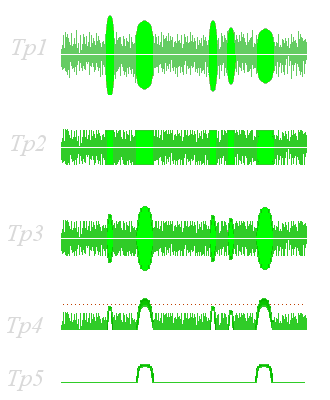“Dicke Fix”- processing
The Dicke-Fix- processing is a circuit in radar signal processing for improving the signal-to-noise ratio. It was used in older electronic protective measures (EPM) systems.
This form of radar signal processing is implemented in the IF amplifier. The principle was perfected around 1960 by Robert Dicke (Defence Research Telecommunications Establishment in Ottawa). A broadband amplifier is followed by a limiter and then the signal is further processed in a narrow-band signal-adapted IF amplifier. This process attenuates signals that are too long (clutter) or too short (noise peaks and pulse interference). The “Dicke Fix” principle was specially developed to protect the receiver from noise interference, from interference from fast wobbled or narrowband pulse-modulated interference transmitters. The “Dicke Fix” principle was used, for example, in the MPR air defence radar.


Figure 1: Block circuit diagram of the Dicke-Fix IF-Amplifier

Figure 1: Block circuit diagram of the Dicke-Fix IF-Amplifier

Figure 1: Block circuit diagram of the Dicke-Fix IF-Amplifier
(See the virtual oscilloscope and use the mousepointer as probe at the testpoints TP1 to TP5.)
Interferences

Figure 2: Diagrams measured in the block circuit diagram
The basic configuration consists of a broadband limiting IF amplifier, followed by an IF amplifier of optimum bandwidth. The limit level is preset at approximately the peak amplitude of receiver noise, the bandwidth may vary from 10 to 20 MHz, depending on the jamming environment. This causes a constant false alarm rate over a wide range of the sweep. The “Dicke Fix”- radar signal processing provides excellent discrimination against fast sweep jamming (10–500 MHz), usually something on the order of 20 to 40 dB, without appreciable loss in sensitivity.
The echo returns with the expected band with (i.e. the expected pulse with) get a higher amplitude than the noise and the interference pulses at the filters output. The noise and the interference pulses can be eliminated by the following threshold-device.
However, strong CW jamming will seriously degrade the performance of the “Dicke Fix”- receiver because the strong CW signal (and slowly swept jamming) overmodulates the receiver.
The word Fix in the “Dicke Fix” was put there to indicate it was a “fix” for a problem that occurred and was to be replaced by something better. Today the “Dicke Fix”-processing is not used in a modern radar, especially one that employs doppler processing. This means, “Dicke Fix”-processing is no longer of interest in many radar applications.
